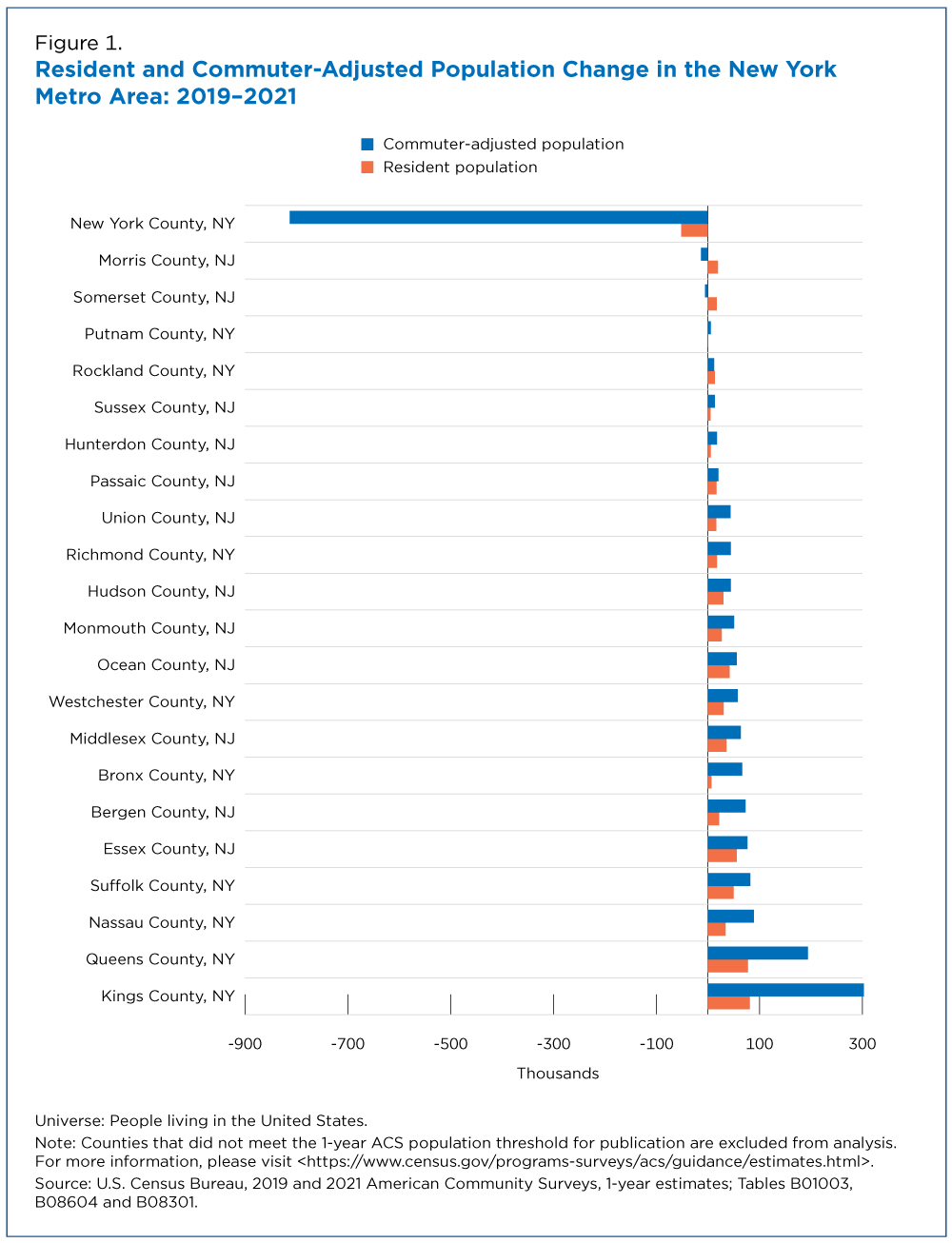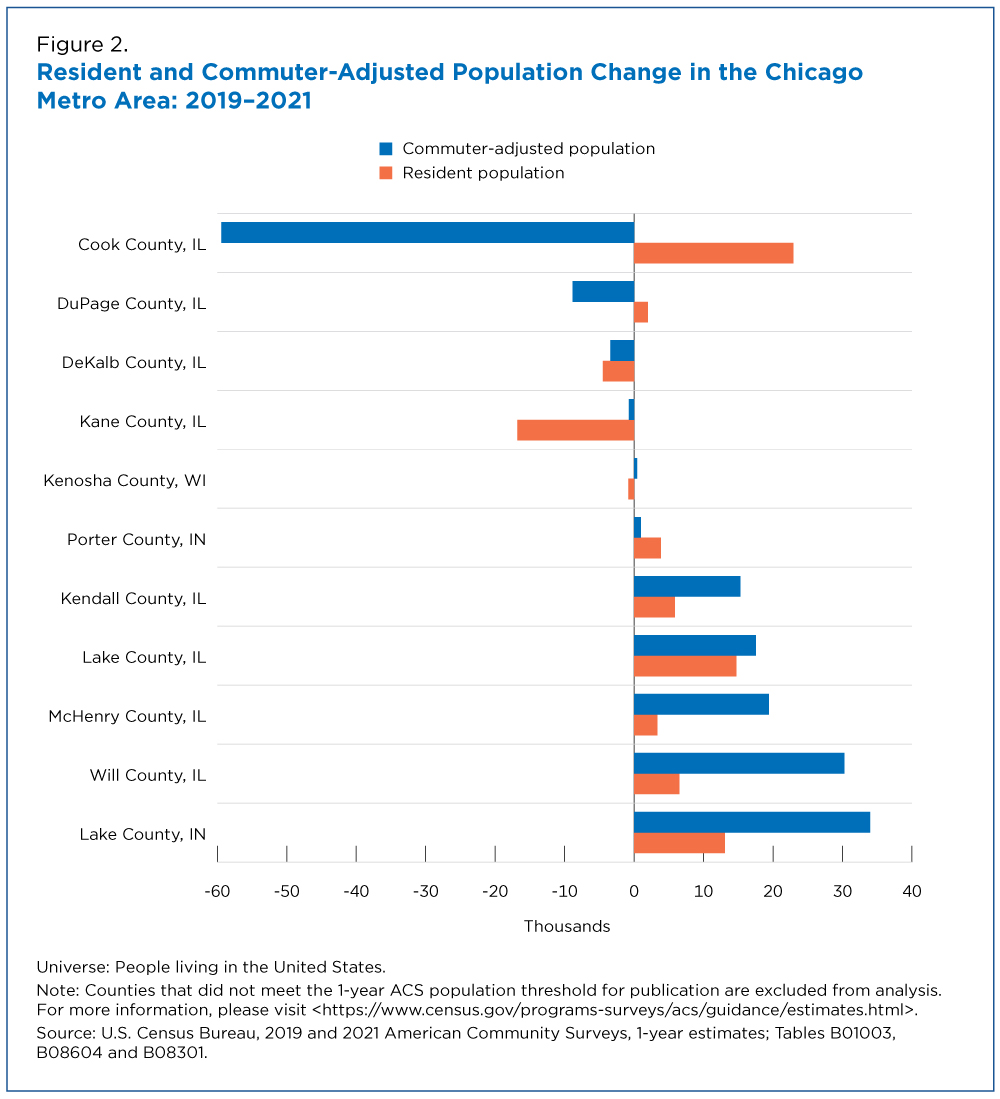Growth in Home-Based Work Decreased Manhattan's Commuter-Adjusted Population by 800,000
The increase in remote work following the onset of the COVID-19 pandemic has drawn attention to the impact of the shift away from traditional centralized employment locations in U.S. cities.
One way of gauging the magnitude of this change is through the commuter-adjusted population estimate, which refers to the number of people in a geographic area during normal business hours. This estimate includes residents of an area who do not work and workers who work in an area regardless of whether they live there, and excludes workers who live but do not work in an area.
This analysis uses 2019 and 2021 American Community Survey (ACS) 1-year estimates to highlight how the dramatic increase in home-based work during the COVID-19 pandemic changed the population distribution of certain key metros during a typical workday.
Kings County, better known as Brooklyn, was the county in the New York metro area with the largest absolute increase in resident and commuter-adjusted population.
The commuter-adjusted population is not a complete measure of how an area’s population may change during a typical working day. It does not account for students, customers, tourists and other transient visitors or for day-to-day differences in workers’ schedules.
Still, the commuter-adjusted population provides a glimpse of how an area’s composition may change due to regular travel to and from the workplace.
The commuter-adjusted population is calculated by adding the people who live in an area to the total number of people working in an area, and then subtracting the total number of people who both live and work in the area.
The examples below describe changes to resident and commuter-adjusted population between 2019 and 2021 in some of the nation’s most populous metro areas. A positive number indicates population increase and a negative number population decrease.
In many cases, changes to the commuter-adjusted population reflect changes to total population. Areas where the commuter-adjusted population changed significantly between 2019 and 2021 may highlight places where home-based work has become more prevalent.
We refer to resident population throughout this article as anyone who resides in an area, regardless of whether or where they work.
Impact on Most Populous Metro Areas
New York-Newark-Jersey City, New York-New Jersey-Pennsylvania
The New York metro area was the nation’s most populous metro in both 2019 and 2021.
It is made up of 23 counties, 22 of which meet the 1-year ACS population threshold for publication. Most counties in the New York metro area saw increases in their commuter-adjusted population between 2019 and 2021 that were greater than increases to their resident population (Figure 1).
Kings County, better known as Brooklyn, was the county in the New York metro area with the largest absolute increase in resident and commuter-adjusted population.
Its total resident population grew by roughly 81,000 between 2019 and 2021, and its commuter-adjusted population by about 300,000. This difference suggests many more people were working in Kings County in 2021 than in 2019.
Indeed, roughly 325,000 workers living in Kings County worked from home in 2021, compared to about 59,000 in 2019 (ACS Table B08006).
New York County (Manhattan) saw the opposite trend between 2019 and 2021, suggesting many people who worked in Manhattan in 2019 did not live there and no longer routinely commuted there two years later. Manhattan’s total resident population decreased by roughly 50,000 people but the drop in its commuter-adjusted population was much steeper – about 800,000 people.
While many more Manhattan residents worked from home in 2021 than in 2019, the increase in home-based workers was far less than the decrease in workers commuting into the area.
Los Angeles-Long Beach-Anaheim, California
Los Angeles, the next most populous metro area in 2021, is made up of just two counties: Los Angeles County and Orange County. Both saw resident and commuter-adjusted populations fall between 2019 and 2021.
In Los Angeles County, both the resident and commuter-adjusted populations declined by roughly 200,000 between 2019 and 2021, and the declines were not statistically distinguishable from one another.
In Orange County, the resident population fell by around 8,000, while the commuter-adjusted population decreased by roughly 50,000 — significantly more than the resident population.
Chicago-Naperville-Elgin, Illinois-Indiana-Wisconsin
In Cook County, Illinois, home of Chicago and this metro’s most populous county, the commuter-adjusted population fell by about 60,000 people despite a gain of about 23,000 residents from 2019 to 2021.
In every other county here that met the 1-year ACS population threshold for publication, the commuter-adjusted population increased or was not statistically different between 2019 and 2021 (Figure 2).
Dallas-Fort Worth-Arlington and Houston-The Woodlands-Sugar Land, Texas
In Texas’ two largest metro areas, the most populous counties were also the only ones that experienced statistically significant declines in commuter-adjusted population.
Dallas County’s commuter-adjusted population declined by around 140,000 and its resident population by around 49,000 people. Harris County’s commuter-adjusted population fell by about 52,000 people, while its resident population increased by about 15,000.
Commuter-adjusted population estimates are just one measure of how people relate to their place of work and the effect that relationship has on their communities. The ACS will continue to collect information about ways communities are changing in the face of new commuting trends.
Related Statistics
-
American Community Survey (ACS)The American Community Survey is the premier source for information about America's changing population, housing and workforce.
-
Stats for StoriesLabor Day: September 4, 2023The 2021 American Community Survey estimated 109.5M full-time, year-round civilian employed population ages 16 and over in the U.S., down from 113.9M in 2019.
-
Stats for StoriesEmployee Appreciation Day: March 1, 2024The American Community Survey estimates that in 2022 there were about 117.0M full-time, year-round civilian workers ages 16 and over in the U.S. and median earn
-
Stats for StoriesEqual Pay Day: March 12, 2024In 1973, full-time working women earned a median of 56.6 cents to every dollar men earned. In 2022 (49 years later), women earned 84.0, a gain of 27.4 cents.
Subscribe
Our email newsletter is sent out on the day we publish a story. Get an alert directly in your inbox to read, share and blog about our newest stories.
Contact our Public Information Office for media inquiries or interviews.
-
America Counts StoryWomen Made Up Majority of Home-Based Workers During PandemicMay 16, 2023The spike in home-based workers during the pandemic slightly increased the share of women working from home.
-
America Counts StoryMore People in All Race/Ethnic Groups Worked From Home 2019-2021April 06, 2023The number of White, Black, Asian and Hispanic home-based workers more than doubled.
-
America Counts StoryRemote Work During the Pandemic Shifted Daytime Population of CitiesFebruary 21, 2023U.S. Census Bureau tools show how the daytime population of urban job centers declined during the pandemic as more employees worked from home.
-
EmploymentThe Stories Behind Census Numbers in 2025December 22, 2025A year-end review of America Counts stories on everything from families and housing to business and income.
-
Families and Living ArrangementsMore First-Time Moms Live With an Unmarried PartnerDecember 16, 2025About a quarter of all first-time mothers were cohabiting at the time of childbirth in the early 2020s. College-educated moms were more likely to be married.
-
Business and EconomyState Governments Parlay Sports Betting Into Tax WindfallDecember 10, 2025Total state-level sports betting tax revenues has increased 382% since the third quarter of 2021, when data collection began.
-
EmploymentU.S. Workforce is Aging, Especially in Some FirmsDecember 02, 2025Firms in sectors like utilities and manufacturing and states like Maine are more likely to have a high share of workers over age 55.






